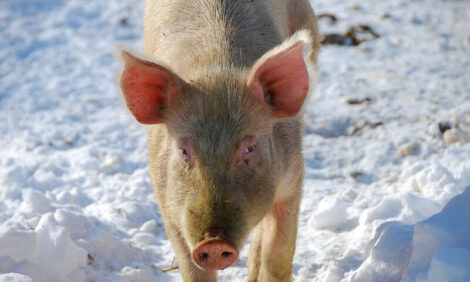



Feeding Glycerol Improves Pork Belly Firmness
US - Feeding pigs eight per cent crude glycerol throughout the growing-finishing period resulted in a three per cent improvement in growth rate and a two per cent depression in gain efficiency, according to new research from the University of Minnesota.Glycerol, a biodiesel co-product, was evaluated in grower-finisher pig diets in terms of supporting growth and pork quality by S.J. Schieck and colleagues at the University of Minnesota, St. Paul. Their paper has been published recently in Journal of Animal Science.
Crossbred pigs (n=216; bodyweight = 31.3 ± 1.8kg) were used to determine the effects of long- and short-term feeding of crude glycerol on growth performance, carcass traits, and pork quality of grow-finish pigs, they explain. Pigs were blocked by initial bodyweight, and pens within blocks were assigned randomly to one of three dietary treatments (24 pens; nine pigs per pen).
Dietary treatments were: control, a corn-soybean meal based diet (CON); long-term, CON + 8.0 per cent glycerol fed throughout the experiment (LT); and short-term, pigs fed CON for the first six weeks followed by CON + 8.0 per cent glycerol fed during the last eight weeks of the experiment (ST).
Pigs fed LT had higher (P<0.05) average daily gain while pigs fed ST tended (P<0.10) to grow faster than CON (CON=0.962kg/day; LT=0.996kg/day; ST=0.992kg/day; SE=0.01).
Pigs assigned to LT had greater (P<0.05) average daily feed intake than CON, while ST-fed pigs had similar feed intake to CON (CON=2.78kg/day; LT=2.93kg/day; ST=2.86kg/day; SE=0.03).
Gain:feed tended (P<0.10) to be greater for CON- and ST-fed pigs than LT-fed pigs (CON=0.346; LT=0.339; ST=0.346; SE=0.002).
Hot carcass weight was greater (P<0.05) for LT-fed pigs than CON, while ST-fed pigs had weights similar to both LT- and CON-fed pigs (CON=94.8kg; LT=97.5kg; ST=96.3kg; SE=0.90).
Dressing percentage of CON-fed pigs was similar to both LT- and ST-fed pigs but LT-fed pigs tended to have higher (P=0.06) dressing percentage than ST-fed pigs (CON=74.5 per cent; LT=74.9 per cent; ST=74.3 per cent; SE=0.16).
Tenth rib backfat and loin muscle area were not affected by dietary treatment.
There was a trend (P<0.10) for LT-fed pigs to have lower fat-free lean percentage than CON fed pigs (CON=53.1 pe cent; LT=52.26 per cent; ST=52.67 per cent; SE=0.25).
Short-term glycerol feeding increased (P<0.05) belly firmness compared to CON, and had similar belly firmness compared to LT-fed pigs (CON=29.46°; LT=35.16°; ST=42.08°; SE=3.07).
Dietary treatment had no effect on pork quality of loins based on taste panel assessments.
Schieck and co-authors concluded that feeding pigs eight per cent crude glycerol throughout the grow-finish period resulted in a three per cent improvement in growth rate and a two per cent depression in gain efficiency compared to control diets.
Grow-finish pigs fed diets containing eight per cent crude glycerol during the last eight weeks before harvest achieved growth performance similar to pigs fed control diets, they said.
The effects of crude glycerol on carcass traits seem to be limited to improvements in belly firmness with short-term feeding of glycerol, according to the researchers.
Reference
Schieck S.J., G.C. Shurson, B.J. Kerr and L.J. Johnston. 2010. Evaluation of glycerol, a biodiesel co-product, in grow-finish pig diets to support growth and pork quality. J. Anim Sci. 1910. doi:10.2527/jas.2010-2858.
Further Reading
| - | You can view the full report (fee payable) by clicking here. |








